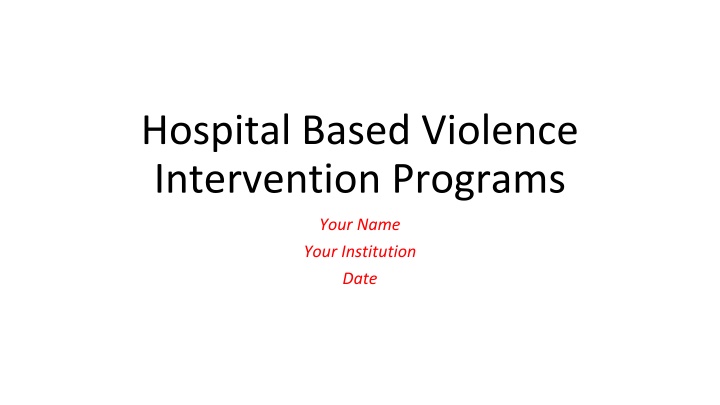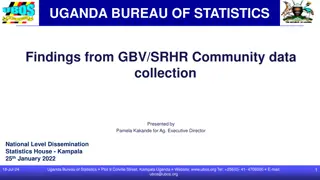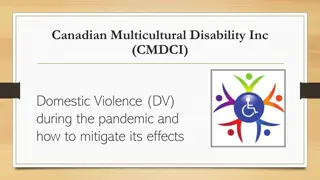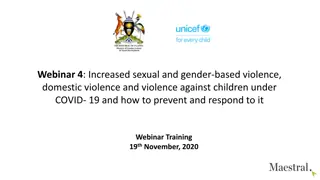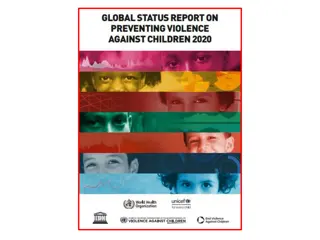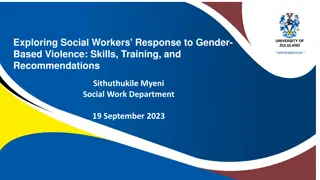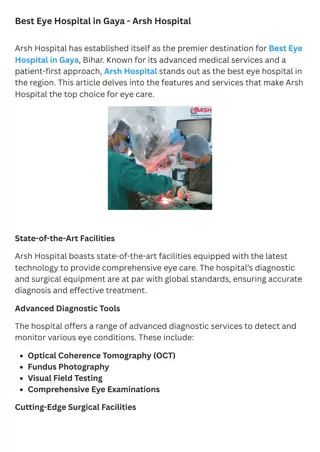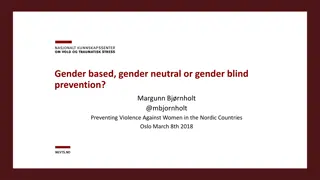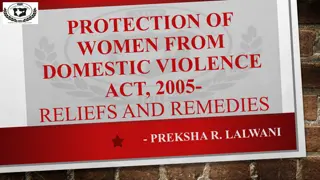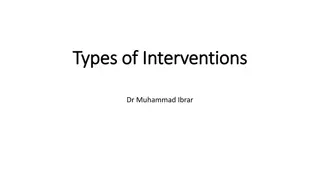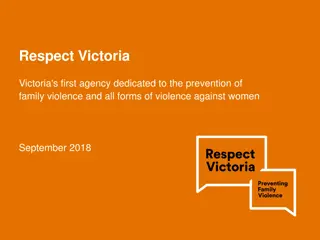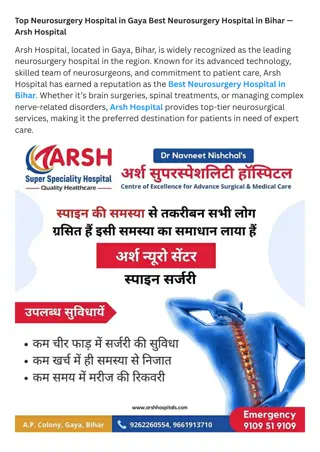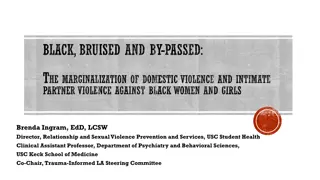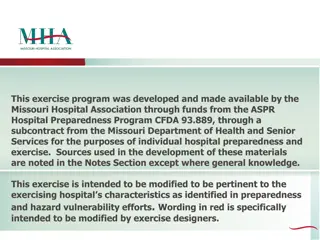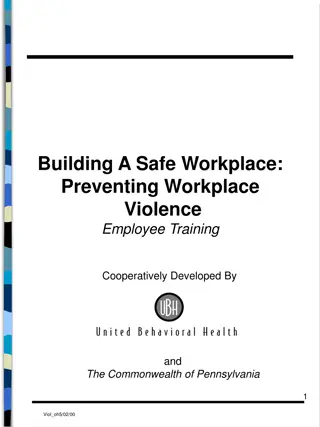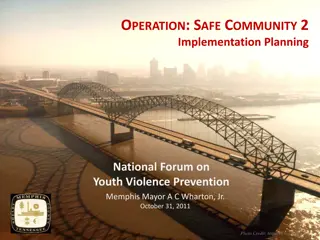Hospital-Based Violence Intervention Programs Overview
Violence is a public health issue in the U.S., with a focus on addressing factors leading to injury and criminal recidivism through Hospital-Based Violence Intervention Programs (HVIP). Learn about the burden of firearm deaths, the public health approach to violence, and the role of trauma centers in prevention, including culturally competent case management strategies.
Uploaded on Mar 01, 2025 | 0 Views
Download Presentation

Please find below an Image/Link to download the presentation.
The content on the website is provided AS IS for your information and personal use only. It may not be sold, licensed, or shared on other websites without obtaining consent from the author.If you encounter any issues during the download, it is possible that the publisher has removed the file from their server.
You are allowed to download the files provided on this website for personal or commercial use, subject to the condition that they are used lawfully. All files are the property of their respective owners.
The content on the website is provided AS IS for your information and personal use only. It may not be sold, licensed, or shared on other websites without obtaining consent from the author.
E N D
Presentation Transcript
Hospital Based Violence Intervention Programs Your Name Your Institution Date
Overview and Objectives Violence is a public health issue Meaningful statistics of violence in the U.S. and local city Factors that lead to injury and criminal recidivism Creation of a Hospital Based Violence Intervention Program (HVIP) Target population of HVIP at Name of your Hospital Importance of data collection, advocacy, and partnerships
Burden of Firearm Deaths Severity and Disparity of Homicide in Youth and Young Adults 33,000 annual firearm deaths 35% homicide 67,000 annual injuries Homicide is the third leading cause of death among Americans 15-34 years old Burden of homicides fall disproportionately on young, minority men #1 cause of death in African Americans 15-34 years old 53 per 100k African Americans #2 cause of death in Latinos 15-34 years old 20 per 100k Latinos Firearm homicide mortality rates among males, 2012
Violence is a Public Health Issue Public Health is Population-Based The Public Health Approach to Violence Focuses on Mitigating Modifiable Root Causes Public Health Approach to Violence is rooted in: Risk Factors Protective Factors Violence affects: Families Communities Populations
Multiple Contributors to Violence - Modifiable Risk Factors Exist
The Trauma Centers Role in Public Health and Prevention 20-40% recidivism rate after being a victim of assault 20% of homicide victims are treated for a violent injury in the 5 years preceding their death Risk Reduction strategies can be provided in trauma centers Utilize the Teachable Moment Culturally competent case management at bedside Community partnerships Public Health Injury Surveillance Advocacy Services Research Policy Prevention & Control Evaluation
Culturally Competent Case-Management Based Model Case managers should be credible messengers Case managers should come from the community, understand urban violence and have knowledge of the community Case managers go to bedside for Teachable Moment The Teachable Moment is a time after which a life-threatening event occurs when an individual is most open to risk factor reduction Case Managers shepherd clients through mental health care and risk reduction resources offered through city and community Employment, tattoo removal, safe schools, vocational training.. 6 months to 2 years, dependent upon client needs and program capacity
Intervention Program Design INJURY Initial Trauma Care Teachable Moment Assessment by Case Managers at Bedside HOSPITAL CARE Low Risk High Risk RECOVERY Referral to Appropriate Resources Intervention Program
Noteworthy Programs Wraparound Project, San Francisco, CA Prospective data, 2005 2011 Participants: 10-30 yr-old high risk patients identified by social workers Interventions: Case management, connection to community resources, follow-up Outcomes: N=254 Recidivism from violent injury significantly lower compared to historical controls (16 vs 4.5%) Journal of Trauma and Acute Care Surgery 2013; 74:976-982
Noteworthy Programs Wraparound Project, San Francisco, CA Services most strongly associated with success: employment and mental health support Journal of Trauma and Acute Care Surgery 2013; 74:976- 982
Noteworthy Programs Bridging the Gap, Richmond, VA Brief in hospital violence intervention (BVI), with community case management (CCM) and follow up Initiated as a prospective randomized study in in 2007 Currently a standard of care at VCU Level 1 Trauma Center Program Participants: admitted patients with intentional injuries 149 patients , age 10-24, (BVI plus CCM) 272 Violence Consultation, age >24, (BVI and referral) Process & Outcomes: Program growth from 0.5 FTE in 2007 to 4 FTE in 2015 Hospital : Decrease Violence Recidivism from 15% to 3.6%; Improved ED resource utilization and clinic visits Community services : > 90% connected to community service programs, including mental health, employment internships. Journal of Trauma and Acute Care Surgery, 2011 July;71(1):228-37; Curr Trauma Rep (2017) 3:79 88
Noteworthy Programs that have Replicated Boston s Violence Intervention Advocacy Program (VIAP) Drexel and CHOP s Healing Hurt People Oakland s Youth Alive/Caught in the Crossfire Baltimore s Violence Intervention Program (VIP) Milwaukee s Project Ujima Indianapolis Prescription for Hope
HVIPs are Cost-Effective for Hospitals Prevention of 3.5 injury recidivists per year render program cost- neutral Program overall saves hospital estimated $500,000 per year when recidivists are considered against the cost of the program Journal of Trauma and Acute care surgery Volume 78, Number 2
Surveillance: Local Burden of Violence Use this slide to populate the local burden of violence vital statistics
Trauma Center at Name of your hospital Number of annual trauma admissions Percent of penetrating trauma Percent of interpersonal violence Recidivism rate for interpersonal violence (usually calculated over 5 years) Homicides in your city per year Demographics of at-risk population (this will be your target population for the program)
Trauma Center at Name of your hospital Insert any press about violence in your community here Insert statement about the value in the hospital building partnerships with the communities it serves
General Steps for setup of HVIPs Needs assessment-Surveillance Completed! Resource building No need to reinvent the wheel: COT and NNHVIP guidelines and mentorship Grant funding Sustainability plan Develop Community Partnerships Implementation Legal agreements and memoranda of understanding Hiring and Finance Training Hospital champion Case management at the core Intervention HVIP provides interventions to patients Data collection Accountability and Evaluation
Timeline for setup of HVIP at Name of your Hospital Month, Year: Needs assessment Month, Year: Resource Building Month, Year: Implementation Month, Year: Intervention
Impact at Name of your Hospital Anticipated length of grant funding: fill in Anticipated sustainability funding: fill in Anticipated number of patients enrolled in year 1: fill in
Snapshot of an Ideal Comprehensive Violence Prevention Program Enough case managers to screen all victims of violence Sustainable funding (line item in city budget or reimbursement through policy change) In-house mental health services Long-term follow-up Expanding the Teachable Moment to the Community Setting Mature quantitative and qualitative analysis expertise Partnerships (formal, with MOU s) with community and city resources Vocational training and Jobs GED/school Tattoo removal Victim of crime office Housing
Research and Evaluation Goals Cost-effectiveness Endpoints in the population at Name of your Hospital Recidivism Job placement Stable housing Connection with mental health services Qualitative value Validation studies for assessment of high-risk patients Add data elements to National databanks run through the Committee on Trauma and the NNHVIP
National support for our initiatives National Network of Hospital Based Violence Intervention Programs (NNHVIP) Provides Mentoring program for new Programs Now over 30 programs Annual Conference for Idea sharing Coordinated with Cure Violence Data sharing and National Databank Multiple Working Groups Publishes Violence Is Preventable guidebook to HVIP setup Best Practices and Curriculum Development American College of Surgeons Committee on Trauma Injury Prevention workgroup Provides a Primer to educate key stakeholders Eastern Association for the Surgery of Trauma American College of Emergency Physicians
